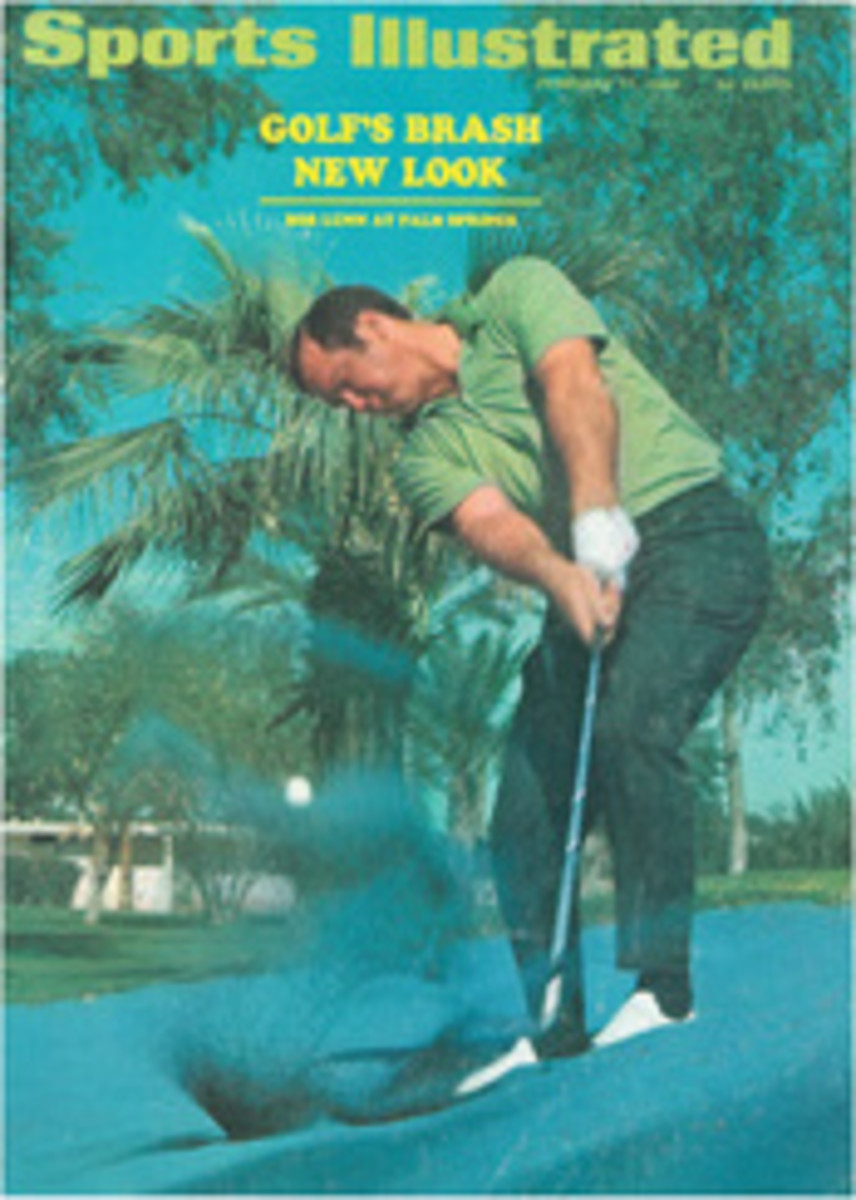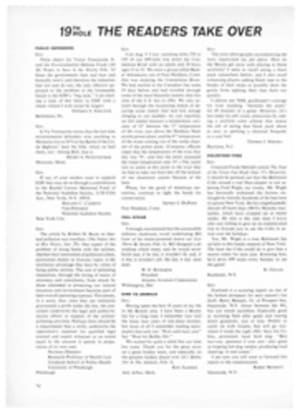
Getting up on a High Horse
Offhand, balloons and horses would not seem to have much in common. Yet the more one examines the history of ballooning as a sport, the more one becomes aware of a curious affinity between it and equestrianism. Maybe it is because the idea of a flying horse has always filled man with the same feelings of envy he experiences at the sight of a balloon in free flight. Or maybe it is simply that, like horses, the first balloons thrived on a diet of hay.
Early balloons floated aloft on hot air, and to provide it they were equipped with iron furnaces which had to be stoked with hay by the passengers. The balloon built by France's famed Montgolfier brothers in 1783 ate like a horse in more senses than one and caused its first noble passenger—a marquis who went aloft with Aeronaut Pilatre de Rozier—some worry because of its habit of belching fire and setting the rigging aflame.
Balloons found a further identification with horses in England sometime later, when another balloonist nearly came to grief because local farmers refused to lend a hand and make fast his landing lines. They were not, they said, about to help anyone who came out of the sky "on a devil's horse."
This may have been the first time that a balloon was actually called a horse, but in 1785, two enterprising brothers in Strasbourg were hard at work devising a balloon that was meant to look like a horse. It was called, naturally enough, Pegasus, and it was made out of oxhide and inflated, like modern balloons, by a crude sort of blowtorch. Whether or not it ever flew is not recorded.
Even if this oxhide Pegasus did get off the ground, however, it was still no more than a balloon shaped like a horse. The dream of sending a real, live horse aloft was not realized until 12 years later. It was a dream long nurtured by Monsieur Tétu-Brissy, an avid fox hunter and balloonist who had once spent an idyllic afternoon following the hounds from the air. To accomplish his dream and thus combine his two favorite pastimes, Tétu-Brissy suspended a heavy platform beneath his balloon, tethered his horse firmly in the center of it and sent the whole rig skyward in what was widely advertised as the first Ascension Equestre.
This history-making first was forgotten almost as soon as it was accomplished. Apparently the whole idea was a little ahead of its time, and the fashion in ballooning went off in another direction, that of long-distance flight. During this period, horses were not entirely forgotten, since someone proposed to Napoleon that he build balloons big enough to carry men and horses across the English Channel, but nothing came of the idea.
Then in 1830 Charles Green, an English aeronaut who had set several long-distance drift records over Europe, began to yearn for a feat more challenging and more significant. He remembered that Tétu-Brissy had once sent a horse aloft on a platform, and he decided to do him one better. Green planned to send his horse aloft not on a platform or in a basket but hanging freely and elegantly in the air, a position that seemed much closer to natural flight.
Not surprisingly, Green's British countrymen did not take kindly to such a highly un-British affront to the dignity (and comfort) of an animal; and so Green took himself to France for his experiments. Britain's newspapers followed him there to report in grisly disapproval on the event. "The horse, a handsome dappled grey," one wrote, "had a stout cloth placed around its body. Several straps, passed over the shoulder and loins, were united in rings, which were attached by cords to the network of the balloon. In this manner was the horse cruelly suspended in the air, nor was there anything to protect the rider, had he lost his balance." After his first successful flight, Green seemed satisfied that the horse had enjoyed it as much as he did and immediately announced that he intended to carry out the same feat in England.
His announcement caused a great commotion. The newly founded Society for the Prevention of Cruelty to Animals sought, unsuccessfully, to have the flight stopped. Whether their protest upset Green or whether, as he thought it over, he realized his personal danger in sitting unprotected in the sky on a horse (who might, like the mythological Pegasus, be bitten by a fly and go berserk) is not known. At any rate, he drastically modified the bold style he had shown in France. The result did not mollify the SPCA and infuriated Green's more sanguine fans. After the exhibition the papers reported that instead of riding aloft on a fine horse the aeronaut had taken a scraggly undersized pony, bandaged its eyes to keep it quiet and tied it into a wicker basket. The pony was so small "it looked like an undersized Newfoundland dog and was hardly strong enough to hold up Mr. Green. This sham equestrian excursion through the air generally disappointed the onlooker."
After this fiasco, so far as we know, Green never went aloft on horseback again. For a while no one else tried it either. For a period of about 20 years no one took any kind of ballooning seriously. The sport had begun to look too easy, and it had lost its early glamour. The only balloons were to be found at county fairs. Then a totally bungled but widely publicized ascension by two Frenchmen, which should have doomed the sport completely, sparked a revival instead.
These two, Barral and Bixio by name, took off in a balloon, which, to begin with, was so tattered that it was being mended by seamstresses even as it was being pumped up. Unfortunately, once pumped up it proved too large for its netting, and the extra bag billowed down like a hernia through the neck hoop onto the gondola, threatening to smother the men inside the basket. Barral bravely climbed up on the rigging to see what he could do to save himself and his companion. What he did was rip the bag so that all the air came out in a whoosh, and both aeronauts dropped like stones to the earth.
Barral and Bixio's catastrophic attempt had in itself nothing to do with the flight of horses, but it did start a new mania for ballooning. Perhaps the very ineptness of the gallant two made balloons seem sporting again.
In England and France there blossomed a brief and wonderful mania for going aloft on horseback. In 1850 and 1851 everyone seemed to be trying it. The London Athenaeum begged the police to do something to "prevent such needless cruelty to animals and to exercise proper supervision over the madmen who undertake such foolhardy feats."
Undeterred by such entreaties, the airborne equestrians kept at it, until not only one horse went up, but teams of them; until not only men went aloft but a lady, too, with everyone in proper riding dress; until the feat was so polished that it could be given at regular intervals for audiences. A spectacular show, called Ascension Equestre, was held at the Hippodrome in Paris, and tens of thousands of Parisians came to watch, with the event being reported in newspapers in England and America. Every Thursday and Sunday Monsieur and Madame Poitevin and a famous balloonist of the period, Eugène Godard, rode high in the sky over the delirious crowds. At last the dream of flying horses had reached its full development.
From a poster printed in 1851 we can see how the trio looked. The three riders are dangling elegantly from one balloon. The gentlemen ride black horses, the lady a white mare. The men have on hunting costumes and spurs; the horses, which appear delighted and proud, wear full bridles. The lady, who is, of course, riding sidesaddle, is dressed in a long, flowing riding skirt and veiled hat; she carries a crop in her gloved hand. One gentleman is doffing his cap to the crowd below; the other is gathering his mount into a collected trot, while the lady's horse is cantering. The houses are not simply dangling in the air; they are going through their gaits and paces.
Having reached an apparent apogee, the sport of sky riding unaccountably faded away until now scarcely anyone takes his horse up in a balloon. But who knows? Hot-air ballooning is on the rise as a sport again today, and its enthusiasts have one form of competition they call the "fox hunt." So maybe soon the horses will be flying once more.

